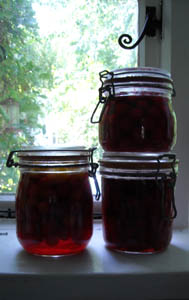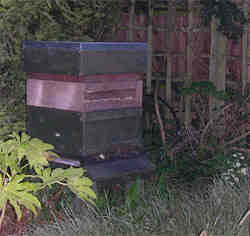Still laid up but I’ve been bottling foraged fruit
Posted by Fiona Nevile in Cottage tales, Hedgerow food, Preserving | 42 comments
Photo: Bottled cherry plums
I’m getting to the end of my third week being in bed. Finally last week my doctor discovered that I have a problem with my kidneys. I was beginning to wonder whether I’d just fade away like one of Dicken’s heroines.
So now we are waiting for more test results. Meanwhile I languish in the big spare room bed feeling lousy. I get up for a couple of hours in the afternoon. I’ve been out on two mini foraging trips to harvest wild plums and have bottled (canned) six kilos to eat in the winter months. I’ve also been harvesting the chubby wild blackberries that grow in our garden for wine and bottling with sliced apples. Gentle satisfying exercise.
We usually make jam, jelly and chutney with the wild cherry plums but this year I wanted to try bottling this fruit. When I was a child my mum bottled a lot of fruit (freezers were rare in those days) and I loved looking at the jars lined up on the larder shelves. Comfortable, squat, their fruit suspended in the coloured syrup.
There’s lots of good advice about bottling on the internet. I found the allotment.org.uk site very useful. In the end I rang my mum and she looked up her old method in her ancient Ideal Gas cookery book. Here are the instructions for bottling plums.
- Make a syrup of anything between 4ozs (113g) to a pound (454g) of white sugar to one pint (568ml) of water. My mum tipped to use the minimum sugar as too much can make the syrup taste sickly.
- Sterilise jars, rings and caps. Always use new rubber seals.
- Wash fruit and discard any bad or bruised fruit.
- Set the oven to Gas Mark ½ (120°C, 250°F).
- Pack the jars very tightly with the plumbs pushing them firmly down.
- Put several sheets of newspaper into a deep baking tray (to absorb any liquid that bubbles over)
- Place the jars two inches apart on the baking tray. Fill to the makers mark (about an inch below the rim) with boiling syrup. Lids on very loosely (not tightened or clipped shut).
- Bake in the centre of the oven for 45 minutes. (Times change depending on the fruit used).
- Remove the baking tray and seal the topsof the jars firmly using a thick oven cloth.
- Leave for 24 hours before testing the seals.
Leave a reply






Hello Michelle (NZ)
Great idea. We are bottling blackberries and a mix of blackberries and apple too. Our freezer always seems to be bursting at the seams.
Hello Jan
I so agree. It’s comforting just looking at the filled jars. And in the winter I know that we’ll really appreciate these.
Hello Toffeeapple
Delighted to be moving forward on the medical front.
Thanks for the hug!
Hi Jackie
Thanks for your advice – much appreciated. Needless to say my tomatoes are still green – hopefully there will be sunshine before long.
Hello Jo
I love those sweet wild strawberries – I made an excellent vodka with them last year!
The cob festival sounds fun.
Thanks for all your good wishes.
Wild balckberries? Wild hazelnuts…?! Crikey, the blackberry profusion (or should I say, confusion) which weaves its tangled, thorny way throughout our ffarm’s hedgerows has only just finished flowering! And as for hazeluts – well, they’re plumping nicely but still nestling snugly in their elf-cap cups; a modest shade of soft sea green.
However the rich crops of fiercely sweet wild strawberries & pump little purple whinberries were bountiful this season; & sadly, all spent.
Harvests in West Wales are evidently a fair bit later in spite of the longer daylight hours (& wetter too – still not managed to get the haymaking done, yah boo hiss). But a lovely day in the picturesque coastal town of Aberaeron at the annual Festival of the Welsh Cob: we were working, but what a fantastic, lively show bathed with plenty of sunshine & sporting the most magnificent horses too – rightfully, the pride of Wales.
Meanwhile its great to know the Docs are a step closer to a successful diagnosis; let’s hope treatment is prompt, painless & speeds you swiftly to recovery.
Big hugs from us & the goats et al –
Jo, Tony & menagerie. xx
Hi Ruth
The rubber seals go on the jars before they go into the oven (it is a very low temperature in the oven so they will be quite safe. If using Le Parfait just drop the lid and do not do up the clips until they have been processed in the oven. With Kilner style jars set the rubber seal on top with the metal screw top loosely fitted – this is tightened after processing in the oven.
Do the rubber seals go in the oven too? Or do they go in when the jars come out?
Warning! You mustn’t bottle veg without a pressure canner – the oven or water bath method is not hot enough, and you risk botulism – which can kill you!
Browse the American sites for info, I imported my pressure canner from the US, but you can use a pressure cooker, I believe, just don’t get much done at a time. The Ball Blue Book is the book you are after for full details.
Same goes for meat by the way – anything not acid – so if you put some peppers in with your tomatoes, Bob’s your uncle, you need to pressure can.
In fact, apparently, as tomatoes get sweeter, they are considered a bit border line, and I always put a good squirt of lemon juice in with mine to be on the safe side.
Plums and other soft and top fruit are of course, definitely acid, and safe to bottle by the oven or water bath method.
Here ends the health and safety lecture! LOL
What a lovely picture!
So pleased that you are in the process of finding out what is wrong and can then address the solution.
Sending you a big hug.
There’s something deeply satisfying about shelves of bottled or pickled or otherwise preserved produce. It must go back to the ancient hunter-gatherer instinct for how to survive the lean winter months.
I do hope you feel better soon. Being ill is incredibly frustrating and boring.
Glad they’re getting closer to the medical solution – time off is lovely but if you’re used to being active and have to rest up it can be very frustrating. Thanks for this post – bottling fruit has always been a bit of a mystery and sounded very complicated in my books but you’ve made this very simple to follow. We’re currently looking after my father-in-law to give mum-in-law a bit of respite and as he’s been so well since we’ve been here we risked leaving him for a couple of hours for a nice walk (they live in a village in the country as opposed to our edge of the town). We were delighted to come across lots of hazelnuts and came back with our shorts pockets bulging = about 4lb in total. Some we picked off trees but lots were obligingly thrown down by the squirrels! The neighbour popped over some apples yesterday too so it seems harvest has begun! Hope they find the solution to your kidney problem so you can get fighting fit again soon.
Another step or two closer for you to finding just what this lurgi is…..
Plums = Yum. Pop a blackberry or 20 into the freezer now so you can pop a handful of these berries into an apple pie or crumble over the colder months. So rewarding to the palate!
sending healing and wellness, Michelle and Zebbycat
Thanks for that – was wondering what I was going to do with some of our produce. Did she bottle veg as well?
Hi Joanna
As far as I can remember she didn’t bottle vegetables.
I’m hoping to bottle tomatoes this autumn.